Get PeakVisor App
Sign In
Search by GPS coordinates
- Latitude
- ° ' ''
- Longitude
- ° ' ''
- Units of Length

Yes
Cancel
Share ×

Scan the QR code and open PeakVisor on your phone
❤ Wishlist ×
Choose
Delete
Scale the highest mountains in Northern Germany when you visit the scenic Harz National Park. There are 197 named mountains in Harz National Park. The highest and the most prominent mountain in the park is the Brocken (1,141/3,743 ft).
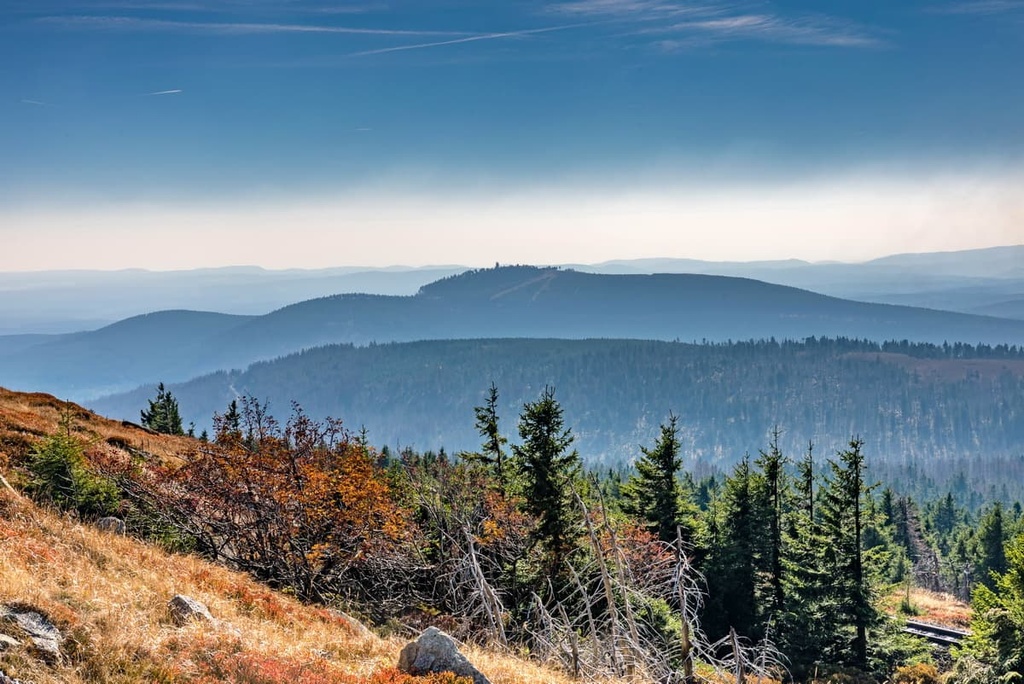
Harz National Park (Nationalpark Harz) is a heavily forested nature reserve in Northern Germany. The park encompasses an area of approximately 247 sq. km (95 sq. mi) in the federal states of Lower Saxony and Saxony-Anholt. Harz National Park was the first German national park to be located in more than one federal state.
Harz National Park contains the western portion of the Harz Mountains, Germany's northernmost mountain range. The park extends from the lower southern mountains near Herzberg am Harz and Bad Lauterberg to the northern peaks of the Brocken massif near Ilsenburg and Bad Harzburg.
Due to its broad reach, Harz National Park features the main characteristics of the entire Harz range. This includes elevations that vary from lows of 230 m (754 ft) to highs of 1,141 m (3,743 ft) and biotopes ranging from rocky mountain summits to dense beech forests.
Approximately 95 percent of the park is forested. Additionally, numerous rivers flow through Harz National Park, notably the Ecker, Oder, Ilse, and Bode. There are also two significant bodies of water in Harz National Park, Oderteich and Edersee. The latter of these is an 11.8 sq km (4.6 sq mi) reservoir created by the Ecker Dam (Eckertalsperre).
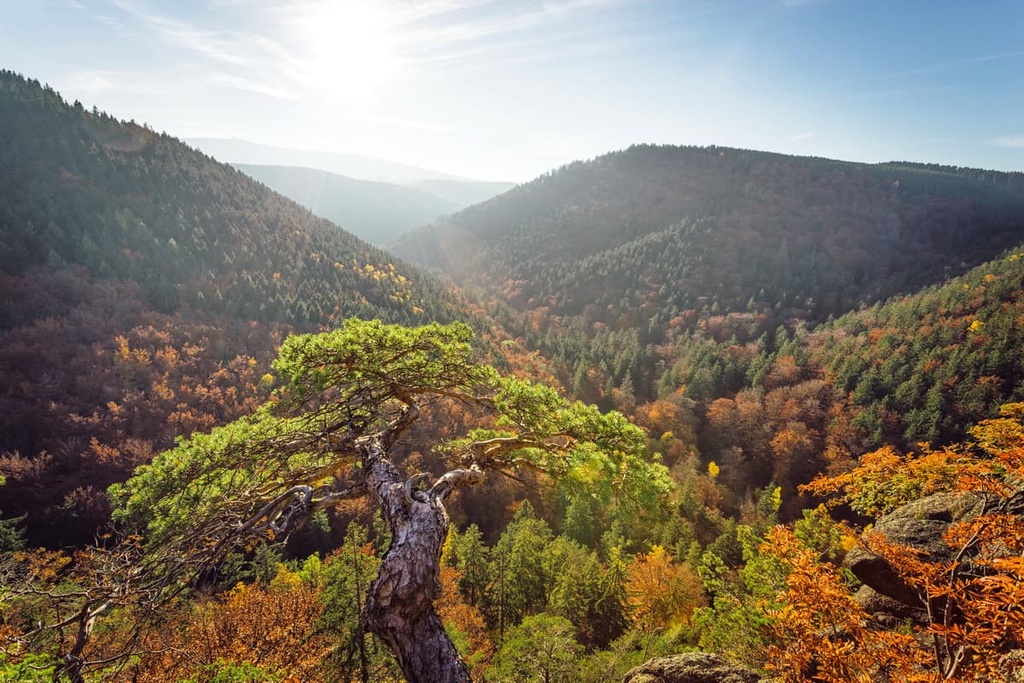
Harz National Park borders several other nature parks within the Harz Mountains, notably the South Harz Nature Park (Naturpark Südharz). The closest national park to Harz National Park is Hainich National Park (Nationalpark Hainich), which is located approximately 90 km (56 mi) to the south.
Harz National Park is sparsely inhabited, except for a few small villages. There are no significant settlements within Harz National Park, but there are several sizable towns that straddle its boundaries.
These towns include Goslar, Bad Harzburg, Herzberg, Bad Lauterberg, and Wernigerode. Furthermore, Hanover, the capital and largest city in Lower Saxony, is located approximately 115 km (71 mi) to the north of Harz National Park.
The Harz is a Mittelgebirge, a German term for a low highland area that’s typical of central Europe, especially central Germany.
The Harz Mountains are very geologically diverse. The area formed as a result of the Hercynian orogeny, which took place during the Paleozoic era between 350 and 250 million years ago. The Hercynian orogeny was a mountain-building event that culminated in the continental collision between Euramerica and Gondwana. It ultimately played an important role in the formation of the supercontinent of Pangea.

Furthermore, the Harz Mountains were lifted between the Early Cretaceous and Late Cretaceous as a single block. Over the next few millions of years, the mountains in the range were subsequently eroded away by the elements.
The northern part of the range was also further uplifted during the sub-Hercynian phase around 83 million years ago. This uplift helped to create the Northern Harz Boundary Fault (Harznordrandverwerfung).
Several types of igneous and sedimentary rocks are distributed across Harz National Park. The most common rocks that you’ll find on the surface in the park include shales, granites, flysches, and greywackes. Limestone and gabbro deposits around Elbingerode and Bad Harzburg have also been the impetus behind extensive quarrying in the region over the centuries.
Today, the Harz rises suddenly from central Germany's lowlands. Its highest areas are located to the north, though the range gradually lowers in elevations as you move further to the south. The mountains in the range are interrupted by several valleys and ravines, notably the 10 km (6 mi) long Bode Gorge (Bodetal).
The highest mountain in Harz National Park is the Brocken (1,141/3,743 ft). Other notable summits include Renneckenberg (936 m/3,071 ft), Bruchberg (929 m/3,047 ft), and Achtermannshöhe (924 m/3,031 m).
Harz National Park provides the perfect snapshot of the diverse nature of central Europe. Read on to find out about the wildlife and plant life of Harz National Park.
Over 5,000 animal species call the Harz Mountains home. The largest mammals that live in Harz National Park include wild boars, mouflons, and red deer.
The park's dense forests are also an ideal habitat for European wildcats. Local conservationists successfully reintroduced the Eurasian lynx to Harz National Park in the year 2000 after a 200-year absence.
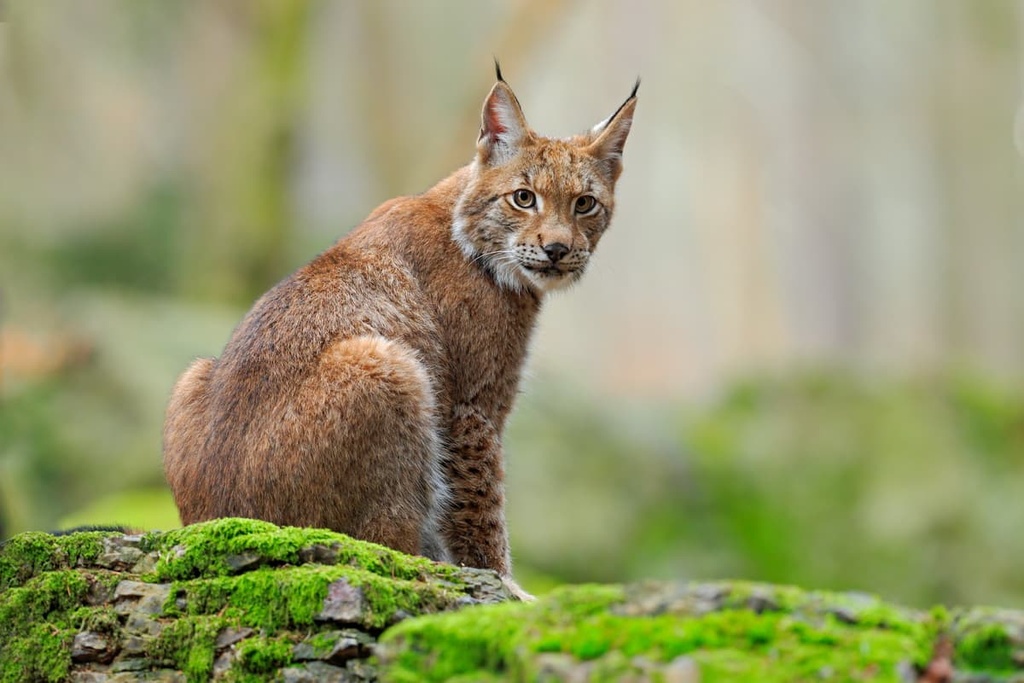
The park's plethora of deciduous forests and rocky mountains also mean that there's an array of bird species present throughout the region. In particular, the park's woodlands support important populations of black woodpeckers, ring ouzels, and Tengmalm's owls. Other notable bird species that nest in Harz National Park include peregrine falcons, willow warblers, spotted nutcrackers, and red crossbills.
A number of common reptile and amphibian species inhabit the Harz Mountains, including alpine newts, common midwife toads, fire salamanders, and green snakes. Brown trout and bullhead live in the park's mountain streams.
Invertebrates are by far the most common animals living in Harz National Park. Many species, such as northern emerald dragonflies and cranberry fritillary butterflies, have had to adjust to living in extreme temperatures in the park over the last few decades. The summit of the Brocken is even home to several rare insect species, like snow flies and snow fleas.
Due to the varied elevations that they contain within their borders, the Harz Mountains can support a myriad of flora.
For example, forests dominate the landscape of Harz National Park. The low forests of the Harz Mountains are beech forests, while the park’s ravine forests consist of beeches interspersed with ashes and maples. Flowering plants like perennial honesty and alpine blue-sow-thistle grow beneath these trees, too.
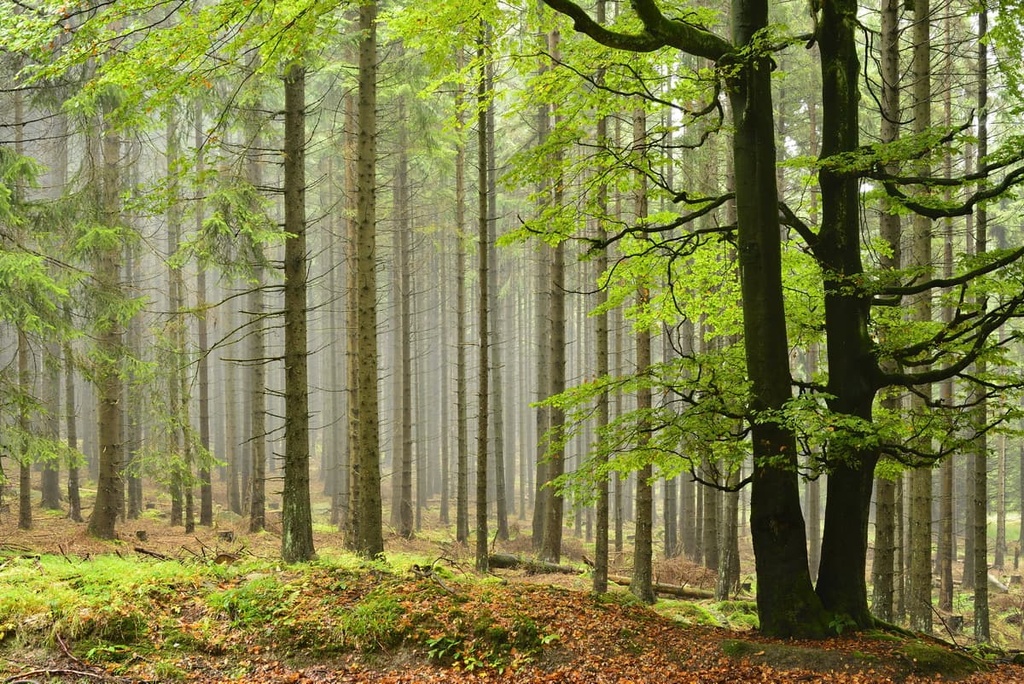
Above 750 m (2,460 ft) in elevation, the park’s beech forests become mixed with sycamores and mountain spruces. Above elevations of 800 m (2,624 ft), spruce is the most common tree species, alongside the occasional rowan, birch, and willow.
No trees grow in Harz National Park over 1,100 m (3,609 ft) in elevation due to the heavy storms that are known to plague the region’s mountains. As a result, this area is primarily dominated by heathlands. Many rare mosses and sedges grow in these areas, including alpine clubmoss, sheathed sedge, and Bigelow's sedge.
The summit of the Brocken has been of great interest to botanists for centuries. The Brocken Garden (Brockengarten), a botanical garden, was opened on the summit of the Brocken in the late nineteenth century. The garden currently contains around 1,500 plants from around the world.
Other notable environments found within Harz National Park include moorlands, dwarf shrublands, and bogs. Additionally, around 1,000 species of fern and flowering plants grow in Harz National Park. Notable plant species that can be found across the park include mountain geranium, bistort, heath pea, knapweed, and round-leaved sundew.
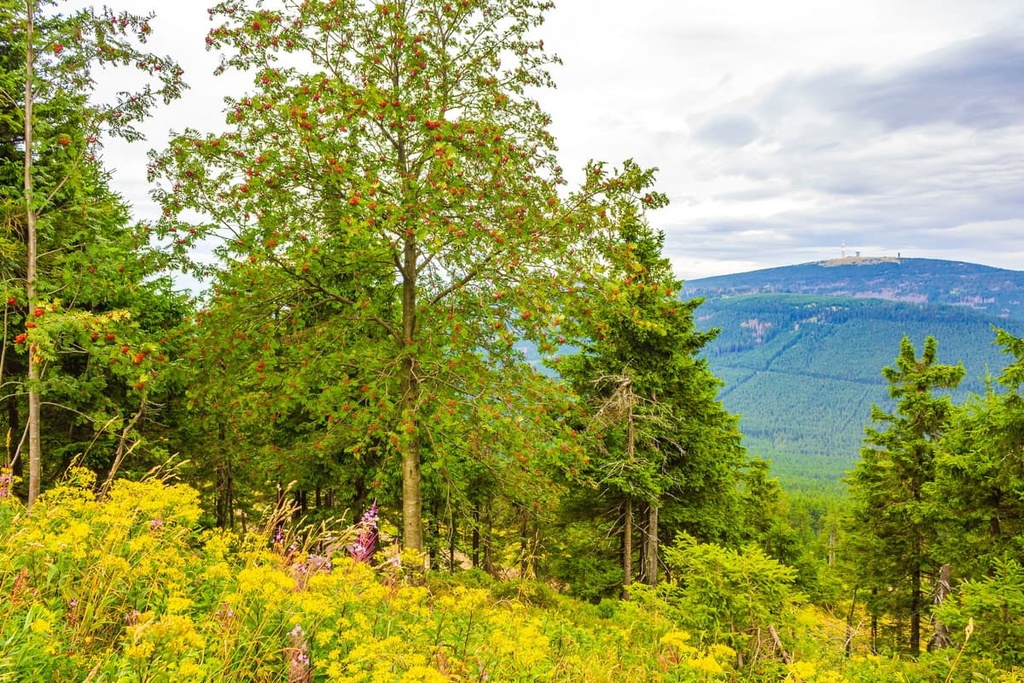
The early human history of the Harz Mountains dates back as far as about 700,000 years ago when Homo erectus hunted in the region’s mountain forests. Archeologists discovered tools used by Neanderthals in the Unicorn Cave (Einhornhöhle) in the southern Harz that date back around 100,000 years.
While Homo sapiens moved to the region around 47,000 years ago, archeologists believe that there were no permanent settlements in the Harz Mountains until around 1,000 years ago. This is due primarily to the density of the mountain range's forests.
The first documented mention of the Harz Mountains was in a ninth-century deed by Louis the Pious, Emperor of the Romans and King of the Franks. This deed states that the area was inhabited by the Harudes, a Germanic tribe first described in written records by Julius Caesar during the Gallic Wars.
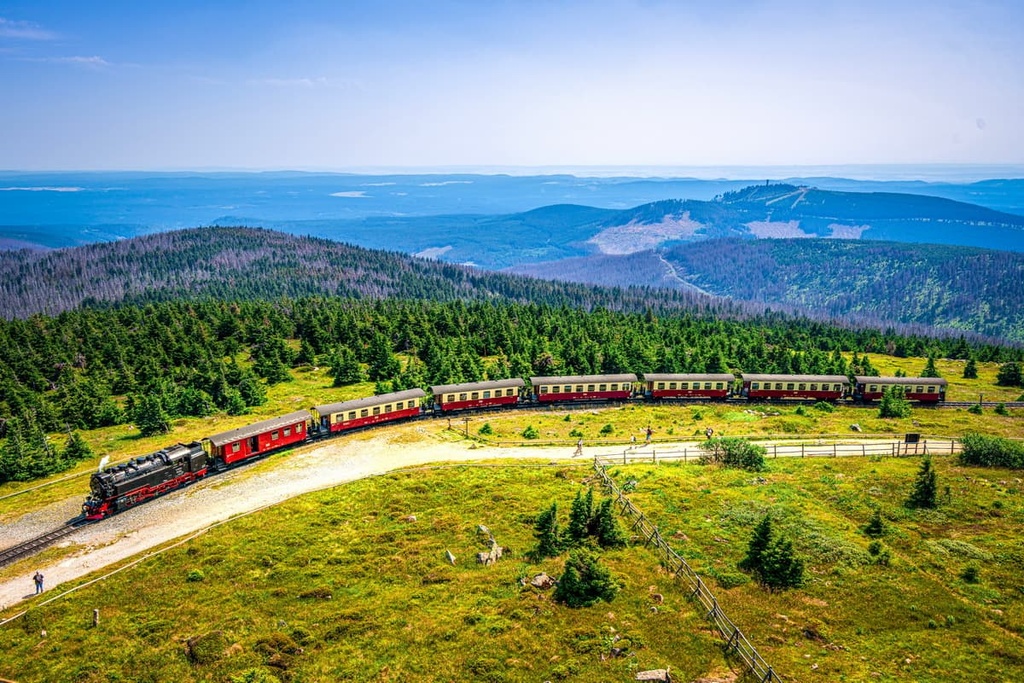
By the fourteenth century, the Harz Mountains were well-populated and both mines and farmlands were established across the area. However, the area’s population had shrunk substantially by the fifteenth century due to the Black Death.
By the late seventeenth century, overexploitation of the Harz's woodlands was becoming a problem. By 1707, Count Ernst of Stolberg had issued court decrees to protect the woodlands around the Brocken.
In the late eighteenth century, famed German poet Johann Wolfgang von Goethe frequently visited the Brocken. At the time, the Brocken was still unpopular with hikers, and the area was shrouded in occult folklore. Due to his experiences, Goethe used the Brocken as the setting of one of the scenes in his most famous play, Faust.
The first mention of establishing a national park in the Harz Mountains dates back to 1926. While the outbreak of the Second World War prevented the establishment of national parks, the Upper Harz Nature Reserve was designated in 1937.
East Germany first established the Hochharz National Park in Saxony-Anhalt on October 1, 1990, two days before German Reunification. Meanwhile, the Harz National Park in Lower Saxony was created in 1994. The two parks merged in 2006 to form a single protected area.

Rich in culture and natural wonders, Harz National Park is very popular with tourists. The Harz Tourist Federation estimates that the park receives over five million overnight and ten million daily visits annually.
You'll find over 600 km (373 mi) of trails to explore across Harz National Park. Before setting off on an excursion in the park, ensure you bring along suitable hiking boots, topographic maps, and plenty of food and water. It’s also important to inform others of your itinerary before you hit the trail.
Consider stopping by one of the park's eight visitor centers before your hike if you're unfamiliar with Harz National Park. There are visitor centers in several towns around the park, including Bad Harzburg, Sankt Andreasberg, Ilsenburg, and Torfhaus. Visit the park's official website for additional information.
The park features a hiking system called the Harzer Wandernadel, which offers badges as rewards for completing different trails by letting you collect stamps from over 220 destinations. If you’re interested in this hiking challenge, consider buying a copy of the Harzer Wandernadel guide before visiting the park.
With that in mind, read on to learn more about some of the best hikes in Harz National Park.
The Brocken (1,141/3,743 ft). is the highest mountain in the Harz Mountains and in Northern Germany. It's also the most popular summit among hikers in the Harz Mountains.
Three subpeaks flank the Brocken: Heinrichshöhe (1,034 m/3,392 ft), Königsberg (1,034 m/3,392 ft), and Kleiner Brocken (1,018 m/3,340 ft). The Brocken is also easily reachable from the spa resort of Schierke, which is located to the southeast.
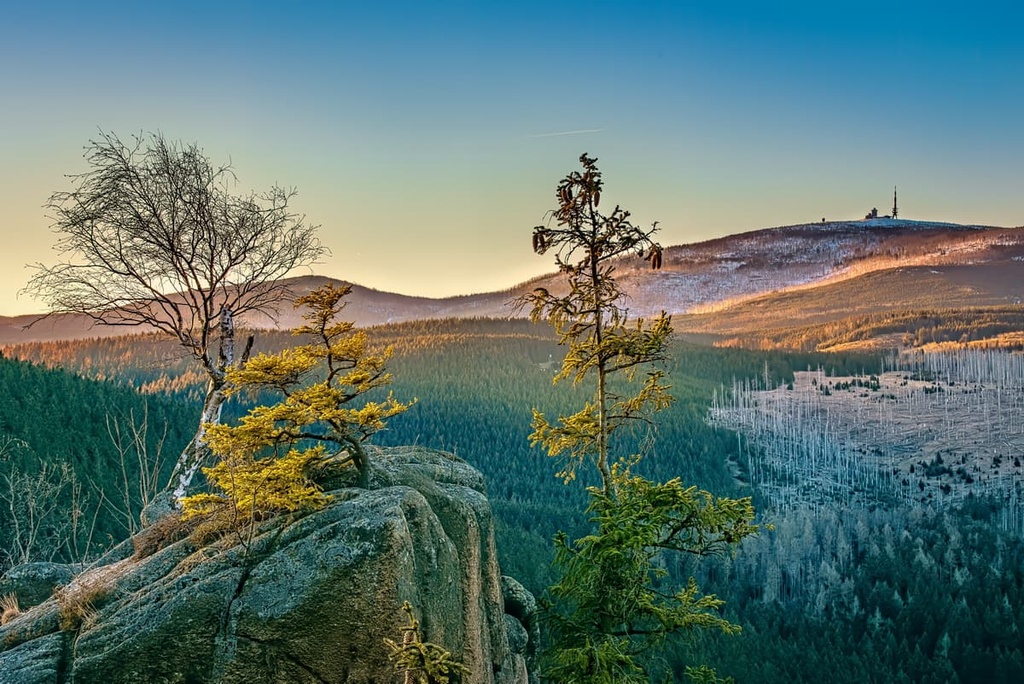
The Brocken is notable for its microclimate, as its summit is located above the treeline and is covered in snow between May and September. For around 300 days of the year, fog shrouds the summit of the mountain, too, providing hikers with a unique and challenging experience.
Atop the Brocken is an old television tower called the Sender Brocken. It now serves as a restaurant and visitor center, complete with an observation deck. Hikers who don't feel like walking up the Brocken can ride the Brocken Railway, which leads up to 1,125 m (3,691 ft) in elevation on the mountain.
One historical way of scaling the Brocken is on the national park's W1 Goethe Way Trail (Goetheweg). This path follows the most likely route that the famous German poet Goethe would've followed in 1777. You can pick up this trail from the Torfhaus Visitor Center (TorfHaus Nationalpark-Besucherzentrum). This route is approximately an 18 km (11 mi) long round trip and takes most hikers 5 or 6 hours to complete.
A short and popular way of scaling the Brocken is on the national park's W4 trail from the Schierke National Park House. The walk leads through the Eckerloch, a popular wooded hiking area. It is approximately a 10 km (6 mi) long round trip and takes most people 4 or 5 hours to complete.
Achtermannshöhe (924 m/3,031 m), sometimes referred to as simply Achtermann, is the fourth-highest mountain in the Harz. It's located approximately 6 km (3.7 mi) to the northwest of the town of Braunlage.
Achtermannshöhe is a popular spot for hikers, as its bald summit is complete with loose boulders and it affords sweeping views of the surrounding forests toward the Brocken and Wurmberg (971 m/3,185 ft). The mountain is also checkpoint number 12 on the Harzer Wandernadel stamp system.

There are several possible ways to approach Achtermannshöhe, but one of the most popular routes is from the small settlement of Oderbrück. It's possible to walk straight to the mountain on a 5 km (3 mi) walk from Oderbrück along a path that takes most people about 1 to 2 hours to complete.
If you’re looking for more adventure, you can also extend your walk by first hiking northeast to the summit of Quitschenberg (890 m/2,920 ft). Afterward, you can loop around to Achtermannshöhe and then head back to your starting point.
Despite being one of the highest summits in the Harz, Bruchberg (927 m/3,041 ft) appears more like a plateau than a mountain. Bruchberg has no notable highest point, though many people consider the Wolfswarte (916 m/3,005 ft) to be its main summit.
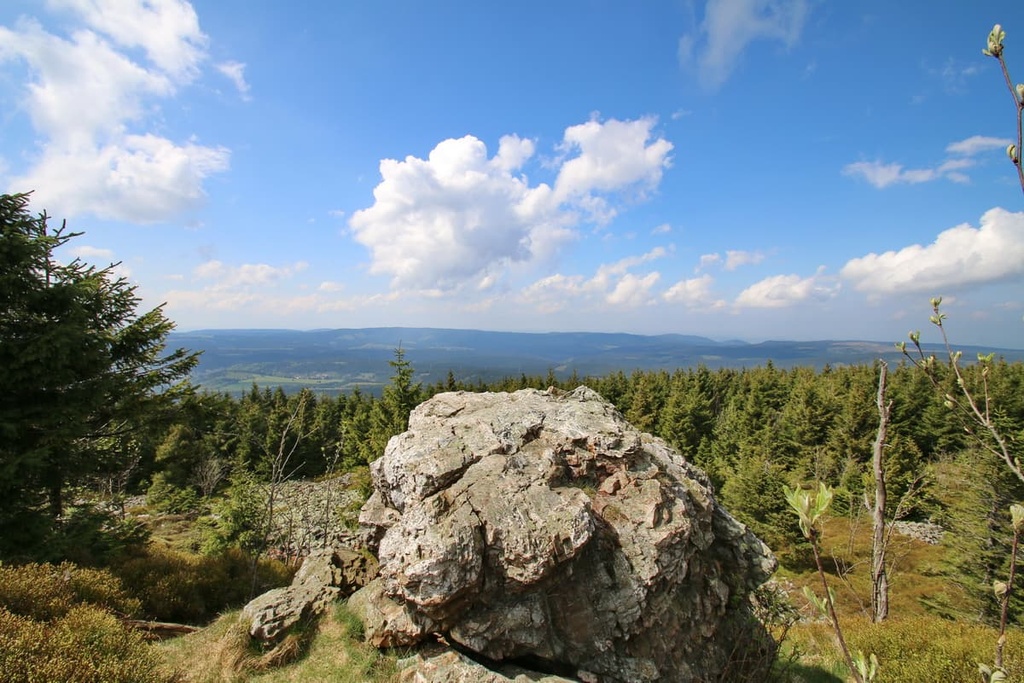
This domed hill used to be covered in woodlands; however, a bark beetle infestation killed large swathes of the forests over the years. As a result, Bruchberg offers some of the best views across the Harz of any mountain in Harz National Park. On a clear day, the Brocken is clearly visible from the Wolfswarte.
It's possible to reach the rocky summit of Wolfswarte from either the Altenau to the west or Torfhaus to the east. From Altenau, you start from the Auf der Rose Car Park (Parkplatz Rose) and follow the looped trail to the summit. The walk is roughly 16 km (10 mi) in length and takes most people around 5 or 6 hours to complete.
A shorter walk to the Wolfswarte is possible from Torfhaus. You can pick up this trail from the Torfhaus Car Park (Großparkplatz Torfhaus). The walk is approximately 4.5 mi (2.7 km) in length and takes around 2 hours to complete.
Harz National Park is home to some dizzying cliffs, and Rabenklippe (564 m/1,850 ft) is one of the finest. The cliff's observation deck provides excellent views of the Brocken on a clear day. The name Rabenklippe translates “raven's crag,” as the cliff is a popular nesting spot for ravens.
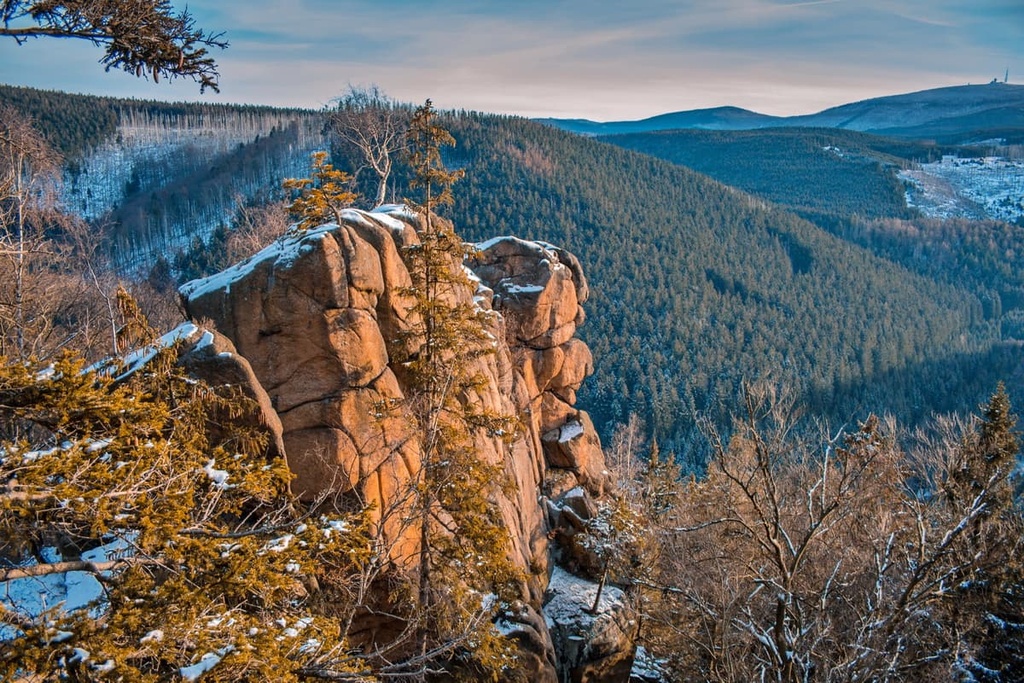
The most popular way to visit the Rabenklippe is on the national park's W2 Way of the Lynx Trail (Unterwegs zu den Luchsen) from the House of Nature (Haus der Natur) in Bad Harzburg. This walk leads to the observation deck at Rabenklippe, where there's a restaurant called Waldgasthaus Rabenklippe.
The visitor center at Rabenklippe also offers some fun family activities and is home to Germany's largest ant farm. One of the highlights of this walk is the lynx enclosure, where it's possible to observe Europe's largest cats and learn about how they've been reintroduced to Harz National Park.
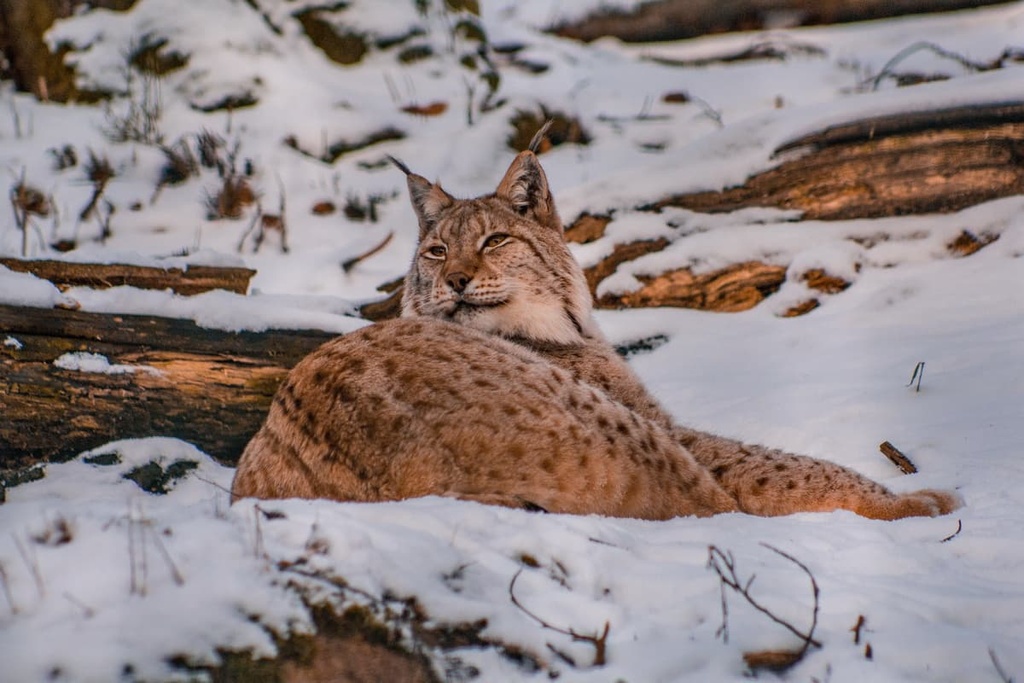
On the return leg of this walk, you can stop by the summit of Großer Burgberg (489 m/1,604 ft) and catch the Burgberg Cable Car (Burgberg-Seilbahn) back to your starting point. This looped trail is 8 km (5 mi) in length and takes around 3 or 4 hours to complete.
This short circular walk around the Große Torfhausmoor, or Great Torfhaus Moor, lets you explore the largest raised bog in the Harz Mountains. This easy walk takes you through an area of great historical and botanical significance.
Part of this walk follows the WaldWandelWeg, a boardwalk trail where you can learn about the dead woodlands that were left behind by a bark beetle infestation. Despite the fact that this trail has a gentle incline, it eventually takes you to Schubenstein (810 m/2 657 ft), which affords sweeping views of the Brocken.
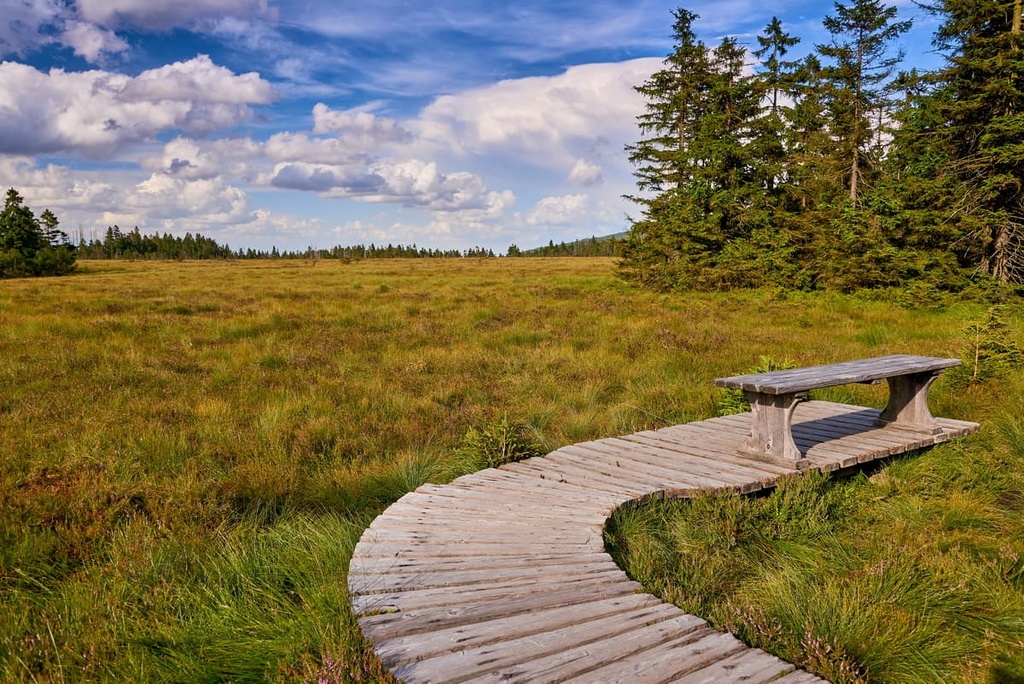
You can pick up this looped trail from the Torfhaus National Park Visitor Center. The trail is roughly 4.5 km (2.8 mi) in length and takes around 1 or 2 hours to complete.
There's no shortage of historic settlements with plenty of Saxon charm to explore during your visit to Harz National Park. Read on to learn about some of the best towns near Harz National Park.
Located 16 km (10 mi) to the north of Harz National Park is the community of Goslar. Goslar is a hugely historic town with over 1,000 years of history. It was founded in the eleventh century as a palatinate and was the seat of the government of Northern Germany for centuries. Its beautiful architecture and numerous churches led to it being called the “Rome of the North.”

During your visit to Goslar, ensure you take a tour of the Rammelsberg Ore Mines, a UNESCO World Heritage Site, and the Imperial Palace of Goslar (Kaiserpfalz Goslar). Goslar also has no shortage of contemporary culture. Each year the town awards the Goslarer Kaiserring, which is considered the Nobel Prize of international art.
Popular hotels in Goslar include Romantik Hotel Alte Münze, Hotel Der Achtermann, and Hotel Harzlodge.
Wernigerode is a classic and picturesque German town. Wernigerode sits on the River Holtemme on the northeastern edge of Harz National Park. It is famous for its Gothic architecture and the nineteenth-century neo-Gothic Wernigerode Castle (Schloss Wernigerode), which rests on a hill overlooking the town.
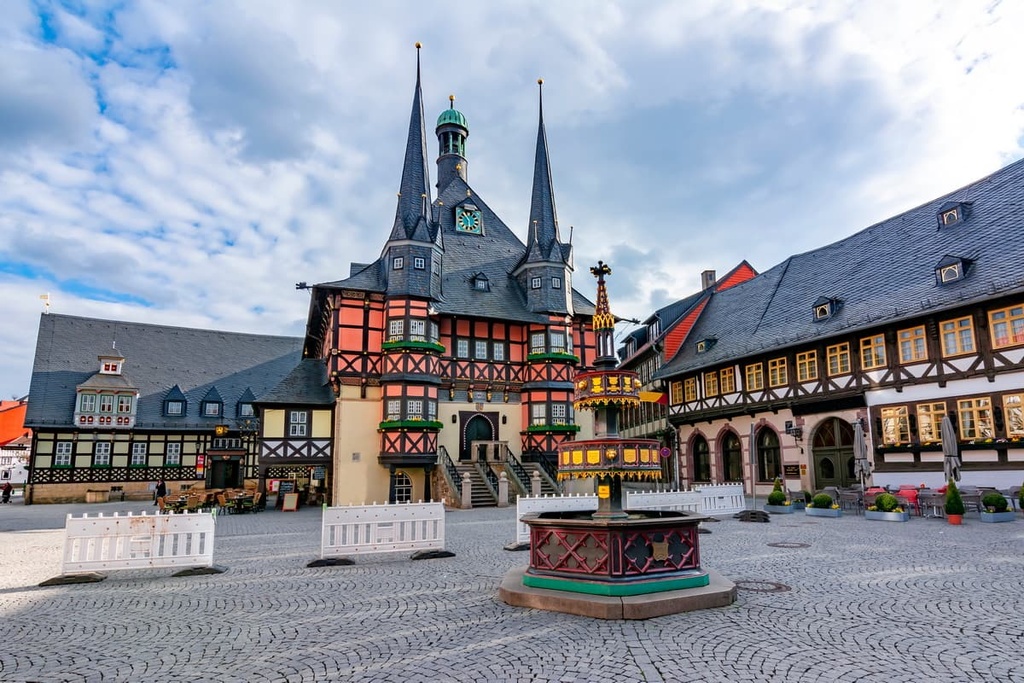
One of the best things to do in Wernigerode is to catch a train on the Harz Steam Railway (Harzquerbahn), which runs all the way to the Brocken. Popular hotels in Wernigerode include Altora Eisenbahn Themenhotel, HKK Hotel Wernigerode, and Altwernigeröder Apparthotel.
Bad Harzburg is considered the gateway to Harz National Park. The town rests on the park's northern boundary in the Radau Valley, where there are over 150 km (93 mi) of hiking trails to explore.
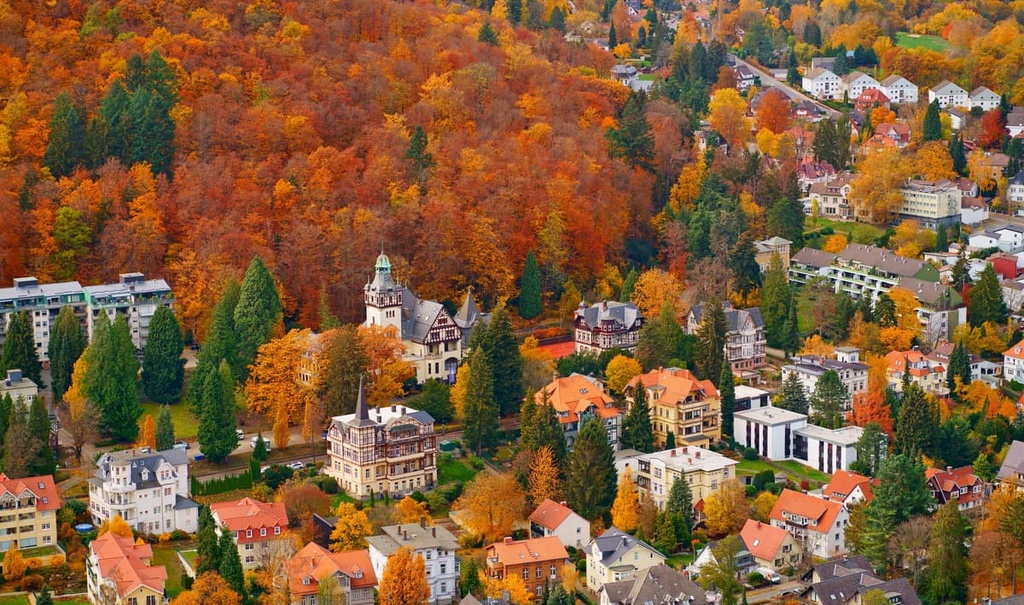
Bad Harzburg is located less than 3 km (1.8 mi) from the Burgberg Cable Car, so it provides easy access to the park's interior. The town is also situated less than 20 km (12 mi) from both the Brocken and Rabenklippe. Bad Harzburg itself is a quaint spa town that's ideal for a peaceful getaway.
Popular hotels in Bad Harzburg include Romantik Hotel Braunschweiger Hof, Parkhotel Bad Harzburg, and Hotel Radau Bad Harzburg.
One of the best towns to stay in on the southern side of Harz National Park is Braunlage. Braunlage is a small tourist village that attracts skiers and hikers from across Germany. It's located close to the ski resorts of Sonnenberg and the second-highest mountain in the Harz, Wurmberg (972 m/3,189 ft).

One of the highlights of visiting Braunlage is riding the 400 m (1,312 ft) high Wurmberg Gondola Lift (Wurmbergseilbahn), which offers spectacular views to the south beyond Braunlage. Braunlage is also located less than 5 km (3 mi) away from Achtermannshöhe.
Popular hotels in Braunlage include AHORN Harz Hotel Braunlage, Harz Hotel Altes Forsthaus Braunlage, and Hotel Spezial.
Book a room in Altenau if you want to stay within touching distance of some of Harz National Park's best trails. Altenau is situated close to the center of the park, and Bruchberg, Torfhaus, and the Brocken are all located within 20 km (12 mi) of the town.
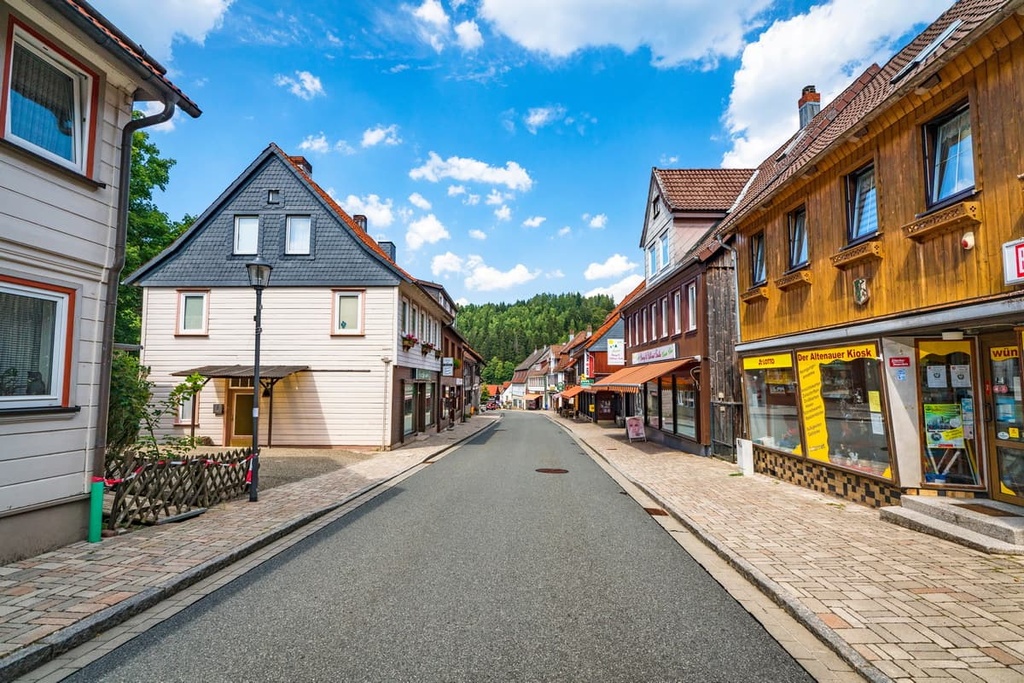
Altenau is a state-recognized health spa and is a popular spot for hiking, biking, and skiing. There's no better base in Harz National Park from which to hike the Goethe Way or explore Tofthausmoor.
Popular hotels in Altenau include Hotel Welt Lodge, Hotel zur Schmiede, and Bio-Hotel Zum Forsthaus.
Explore Harz National Park with the PeakVisor 3D Map and identify its summits.








